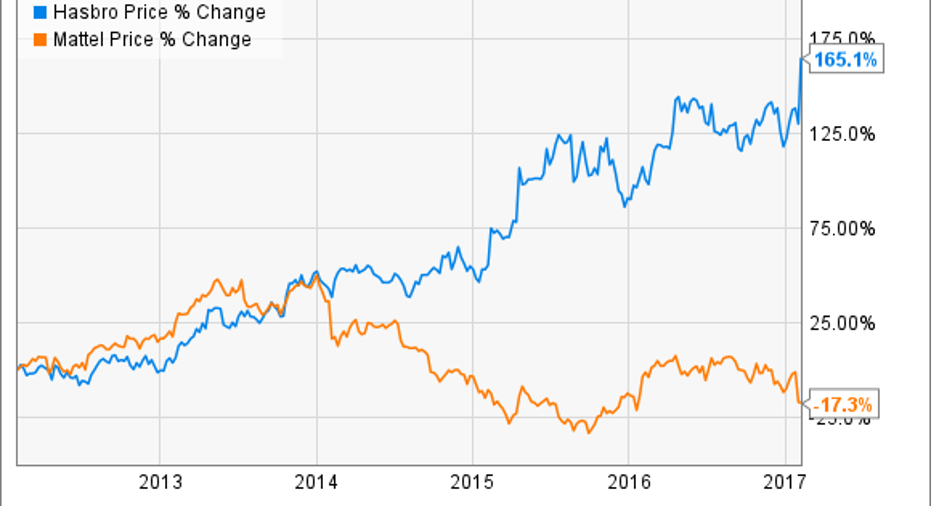How Hasbro Has Changed in the Last 5 Years

You can say the last five years have been kind to toymaker Hasbro (NASDAQ: HAS), which has seen its shares rise by more than 150% over that time frame, while rival Mattel (NASDAQ: MAT) has lost nearly a fifth of its value. The S&P 500 index was up less than half that amount, rising 70% over the past half decade.
Yet as much as Hasbro has changed over the past few years, it remains -- at heart -- the same company it was back then. Below, I'll highlight the changes investors should consider most as they think about the next five years for the toymaker.
Narrowing the gap on sales
As one would expect from a company that has gained so much in such a relatively short span, Hasbro is a bigger company today. It ended 2011 generating almost $4.3 billion in sales while it just reported that revenues in 2016 broke through the $5 billion mark, a 16% gain, or better than 3% growth compounded annually. No barn-burner, for sure, but Mattel's revenues shrank by almost 3% annually, to $5.4 billion. Some time this year, it ought to overtake its rival.
The company's major segments remain unchanged in their contribution to the total. Boys is still the biggest contributor, followed by games and puzzles, girls, and preschool. But their relative importance has developed over time.
Totals may not add to 100.0 due to rounding. Data source: Hasbro SEC filings.
While all of the segments have grown over the past five years, it's clear that girls toys are what's driving Hasbro forward, and that's due in no small part to it having wrested control from Mattel the rights to make and market for Disney (NYSE: DIS) the line of Frozen and Princess dolls. It took formal possession of the rights at the start of 2016, and segment sales have soared 50% since.
More profitable now, too
Where Mattel used to dominate Hasbro in profit margins, the scales have flipped, and now Hasbro is the clear leader, with margins about double those of its rival.
HAS Profit Margin (TTM) data by YCharts.
The sales surge certainly helped boost Hasbro's net profits last year, which hit $551 million, up from $451 million a year ago and 43% higher than in 2011. In contrast, Mattel's profits plunged by nearly 60% over the last five years.
When Mattel reported earnings last month, it blamed a slowdown in the overall toy market for the decline it suffered. While its stock lost nearly a fifth of its value in one day, it dragged down Hasbro shares, too, as investors figured it would also report weak results. Now it's clear the impact wasn't even throughout the industry, and Hasbro is emerging as the powerhouse brand in toys, games, digital, and movies.
Calling the shots
While a company's cash position can fluctuate over time for many reasons, the bigger, stronger, and more successful it is, the faster those balances will grow.
Hasbro's cash balance at the end of 2016 stands at $1.3 billion, 31% more than last year and double its 2011 balance. That's a nice war chest to have, and while it paid out in 2016 almost $250 million to shareholders in dividends (and another $151 million in share buybacks), that leaves it with plenty of cushion to be acquisitive if it wants.
One company that often crops up, and which Hasbro has even explored buying at various times, is Mattel. Now with its rival in a weakened state and itself more financially secure, the idea of it merging with its fellow toymaker could receive a big push.
What the future holds
Even if it's still runner-up in revenues at the moment, it's obvious that Hasbro is in the toy industry's driver seat. In addition to the lucrative Disney franchises, it also continues to reap the harvest of its other properties, including Star Wars and Transformers. The former just had a movie hit the big screen, and the latter will have the next installment in its franchise hit this summer. Whenever there's a Transformers movie at the box office, Hasbro's results explode.
Image source: Hasbro.
Beyond that, there are more movies to be made, TV shows to produce, and of course, toys and games to unveil. Hasbro usually has the benefit of one segment performing well if another declines. In the last quarter, sales of boys toys fell 2%, which was more than made up by the girls segment. In the past, it's been the opposite.
With the possibility of a transformational merger on the horizon, it's clear the Hasbro of five years from now won't be the same toymaker we see today.
10 stocks we like better than HasbroWhen investing geniuses David and Tom Gardner have a stock tip, it can pay to listen. After all, the newsletter they have run for over a decade, Motley Fool Stock Advisor, has tripled the market.*
David and Tom just revealed what they believe are the 10 best stocks for investors to buy right now...and Hasbro wasn't one of them! That's right -- they think these 10 stocks are even better buys.
Click here to learn about these picks!
*Stock Advisor returns as of February 6, 2017.
Rich Duprey has no position in any stocks mentioned. The Motley Fool owns shares of and recommends Hasbro and Walt Disney. The Motley Fool has a disclosure policy.